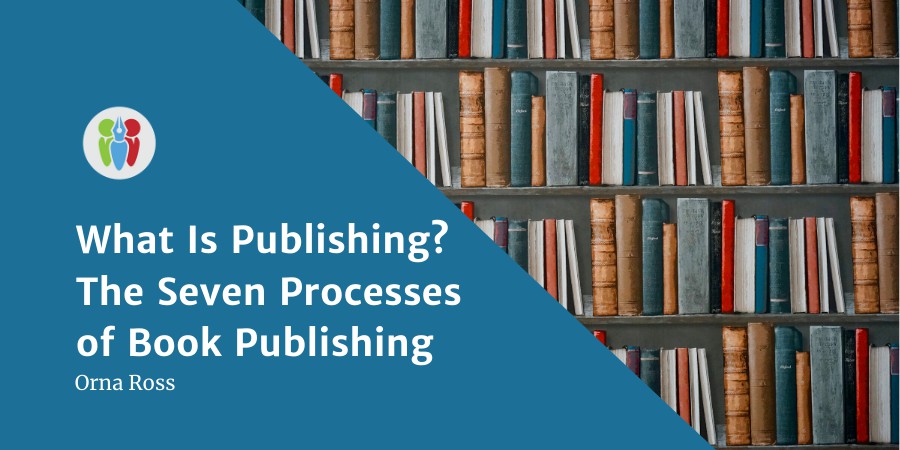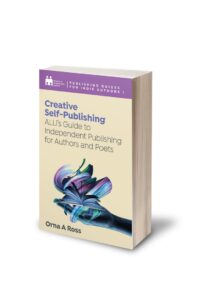Anyone who sets out to publish a book needs to understand the seven processes of publishing. If you're scratching your head or you've never heard of them, don't worry. In this extract from her book Creative Self-Publishing, ALLi Director Orna Ross explains each process and why they matter to indie authors and other publishers.
Tell someone you're an author and the next question they'll most likely ask is “are you published”?
What they usually mean by that is: “Has somebody else invested in your book?” (Subtext: “Are you actually an author — or are you really a deluded wannabe?” )
Few people outside the business understand that being “published” is not a matter of some other business deciding your book is good enough. But publishing is not just the act of making a book, with an appropriate cover and properly edited text. It’s not getting a book printed. It’s not the moment when you press the “publish” button on a self-publishing platform. And it’s certainly not when a commercial publisher in London or New York decides a manuscript deserves a contract.
So what is it?
Whether these are done by you, the author, or somebody else we call “a publisher”, is irrelevant to the reader–so long as the processes are properly done.
Knowing the seven processes of publishing is useful for all publishers, especially indie authors who can get confused — especially in the early days of their publishing business — about where the writing ends and the publishing begins.
Understanding the discrete nature of each process allows you to see which ones you can (or must) tackle yourself, and which you can hand over. And where you need to improve if you want to become a better publisher.
We can all be better publishers than we are today. Like writing, publishing is both art and craft, and that mean it's never perfected. But today's technology has made possible things that were never possible before –and gives authors scope for endless improvement and expansion in each process of publishing.
The Seven Processes of Publishing: The Formats
Before listing the seven processes of publishing, a quick look at formats. In the old days, books began as print and in a publishing contract, electronic or audio editions were handled as “subsidiary” to that ore format. Hence a whole section in publishing contracts covering subsidiary rights.
Today's indie authors use digital tools to produce books in three formats: ebook (electronic), pbook (print), and abook (audio) and most authors now start with the cheapest and easiest format which is ebooks.
We all have our preferred reading format and many older readers, in particular, are romantic about print, loving the feel, the smell and the weight of a print book in the hand. A good author-publisher knows that how we ourselves like to read, as a reader or writer, is irrelevant. Our job as a publisher is to get our books into as many formats as possible so that the readers can choose their own preferred format.
If you are currently publishing your first book, ALLi recommends you begin with making, supplying and sell an ebook first, as it's the easiest and cheapest format to work with. Ebooks will set you up fastest for book sales and allow you to make your inevitable mistakes more cheaply, and in a way that is easiest to rectify and change.
The elements and processes of publishing are the same across the three formats. Once you've mastered ebooks, you can build on those skills to produce print and audio, the tricker formats that need more investment.
So what are those elements and processes?
The Seven Processes of Publishing: Three Elements
The three elements of commercial book publishing are: book making, books supply and book sales. These three elements encompass seven key processes that make up the craft of publishing.
Publishing Element One: Book Making
Publishing Element Two: Book Supply
Publishing Element Three: Book Selling
The Seven Processes of Publishing: Questions That Arise
During the different processes of book publishing, very different questions arise.
Making the Book: Questions
This function includes editorial, design, and production: getting the text edited, the front cover and interior layout designed and produced. The kinds of questions we ask during the making phase include:
- How do I master the editorial, design, and production tasks I can, need, and want to do?
- What skills do I need to improve?
- What skills can I improve, and which ones do I need to accept that I need help with?
- Who do I get to help me? Where do I find good self-publishing services? (Hint: you can start with the ALLi Directory)
- If I am self-publishing for the first time, will I use a full-service self-publishing company or assemble my own team of freelancers and publish directly to Amazon and/or others?
- Where do I get feedback on my book, the cover, and other production matters?
Having mastered the intricacies of making a book, the author-publisher's attention then turns to reaching readers, book marketing, and promotion.
Supplying the Book: Questions
This function includes distribution and marketing. Distribution is about who's going to take your book out to the world, make it available. Then marketing is about ensuring that it is discoverable.
Book marketing and promotion are often confused, or spoken of together, but they are not the same thing. Marketing centers on what the book publishing business calls “discoverability”, ensuring that you and your books can be found by the right readers. Marketing includes your author platform, your book covers and descriptions and reviews, your email list and digital funnels, and encompasses your promise to the reader. It's your marketing that allows readers to know what to expect from you and your books and it's an ongoing, ever-growing process.
Book promotion is time-based and sales-based, and usually a drive around a particular book. Promotions take many forms, including book launches, virtual or real-life book tours, advertising, and other purchased promotions.
- What genres do I write in and who else writes in these genres?
- Who is my ideal reader?
- What is my USP, the one thing I do that other authors don't do?
- How do I best reach my ideal readers? What is my marketing plan?
- How do I balance marketing and promotion tasks with writing more books?
- How do I integrate the creative heart of my books into my marketing materials and sales pages?
- Where do I best invest my resources of time and money?
- What partnerships and collaborations can I make to increase my books' impact, influence, and income?
Selling the Book: Questions
Indie authors are careful about the contracts we sign and do what we call “selective licensing”, limiting the term and territory and time for which we license our rights to any trade publisher, or any other rights buyer. The kinds of questions we ask around rights management include:
- What promotions give me the best return on investment
- Where's the best place for me to advertise this book?
- How might I sell my books abroad?
- How can I profitably get my books into physical bookstores?
- What do I do if I'm approached by a trade publisher?
- What about subsidiary rights like radio, film, and television? Which do I self-publish, which do I trade?
- How do I best exploit my intellectual property?
What are the seven processes of publishing for profit? @ornaross explains #selfpublishing #IARTG #ASMRG #selfpublishing #selfpub #indieauthors Share on X
This is an extract from Creative Self-Publishing by Orna Ross.
OVER TO YOU
What stage of the publishing process are you at? Have you faced any barriers or hurdles trying to get to the next process?







This article was helpful as a new author who has yet to publish. Thank you for making the information digestible and not too overwhelming.
Very interesting/informative since I finished my fictional novel and am looking to publish (new years resolution!). Have been and will continue to scour the ALLI Directory for quality independent publishers. Joined ALLI as Associate Member and will be accessing as many resources as my schedule allows (work 3 jobs on top of writing endeavors). While doing all of the above described activities (in addition to continuing to participate in local writers groups), my intention is to regularly reach out (targeted outreach) to publishers on the ALLI Directory. Wanted to run this by you as a strategy. Best wishes for 2020!!!